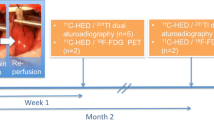Abstract.
Doxorubicin is one of the most useful anticancer agents, but its repeated administration can induce irreversible cardiomyopathy as a major complication. The purpose of this study was to investigate doxorubicin toxicity on cardiac sympathetic neurons using iodine-131-metaiodobenzylguanidine (MIBG) and protein gene product (PGP) 9.5 immunohistochemistry, which is a marker of cardiac innervation. Wistar rats were treated with doxorubicin (2 mg/kg, i.v.) once a week for 4 (n=5), 6 (n=6) or 8 (n=7) weeks consecutively. Left ventricular ejection fraction (LVEF), calculated by M-mode echocardiography, was used as an indicator of cardiac function. Plasma noradrenaline (NA) concentration was measured by high-performance liquid chromatography (HPLC). 131I-MIBG uptake of the left ventricular wall (24 ROIs) was measured by autoradiography. 131I-MIBG uptake pattern was compared with histopathological results, the neuronal population on PGP 9.5 immunohistochemistry and the degree of myocyte damage assessed using a visual scoring system on haematoxylin and eosin and Masson’s trichrome staining. LVEF was significantly decreased in the 8-week group (P<0.05). The serum NA level also showed no statistical difference until 4 weeks and was significantly increased in the 8-week group (P<0.05). MIBG uptake was decreased in the 6- and 8-week groups (P<0.05), and was closely correlated with the reduction in the number of nerve fibres on PGP 9.5 stain. Myocyte damage was seen only in the 8-week group. Neuronal population and the 131I-MIBG uptake ratio of subepicardium to subendocardium were significantly increased (P<0.05) in the 8-week group as compared with the control group. It may be concluded that radioiodinated MIBG is a reliable marker for the detection of cardiac adrenergic neuronal damage in doxorubicin-induced cardiomyopathy; it detects such damage earlier than do other clinical parameters and in this study showed a good correlation with the reduction in the neuronal population on PGP 9.5 stain. The subendocardial layer appeared to be more vulnerable to doxorubicin than the subepicardium.
Similar content being viewed by others
Author information
Authors and Affiliations
Additional information
Received 14 December 1999 and in revised form 2 February 2000
Rights and permissions
About this article
Cite this article
Jeon, T., Lee, J., Ha, JW. et al. Evaluation of cardiac adrenergic neuronal damage in rats with doxorubicin-induced cardiomyopathy using iodine-131 MIBG autoradiography and PGP 9.5 immunohistochemistry. Eur J Nucl Med 27, 686–693 (2000). https://doi.org/10.1007/s002590050563
Issue Date:
DOI: https://doi.org/10.1007/s002590050563




